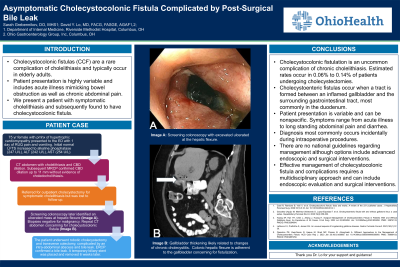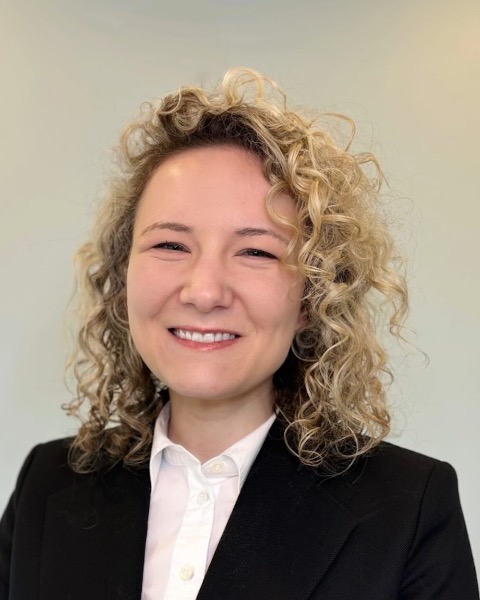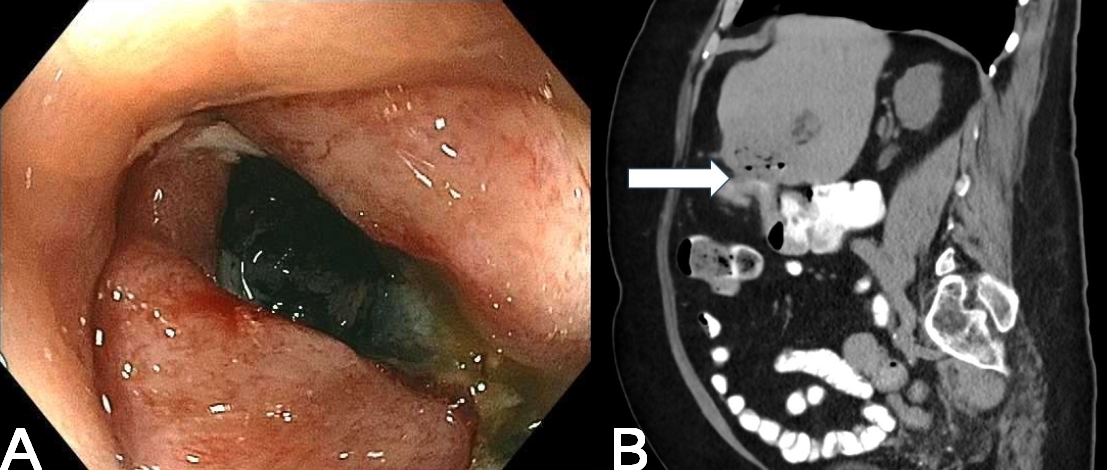Tuesday Poster Session
Category: Biliary/Pancreas
P3521 - Symptomatic Biliary Colic Resulting in Cholecystenteric Fistula
Tuesday, October 29, 2024
10:30 AM - 4:00 PM ET
Location: Exhibit Hall E


Sarah Grebennikov, DO, MHS
OhioHealth Riverside Methodist Hospital
Columbus, OH
Presenting Author(s)
Sarah Grebennikov, DO, MHS1, David Y. Lo, MD2
1OhioHealth Riverside Methodist Hospital, Columbus, OH; 2Ohio Gastroenterology Group, New Albany, OH
Introduction: Cholecystocolonic fistulas (CCF) are a rare complication of cholelithiasis and typically occur in elderly adults. Presentation is highly variable including acute illness mimicking bowel obstruction as well as chronic abdominal pain. We present a patient with symptomatic cholelithiasis and subsequently found to have cholecystocolonic fistula.
Case Description/Methods: A 75-year-old female with a history of hypothyroidism presented with right upper quadrant abdominal pain, nausea and vomiting. Liver function tests (LFTs) were normal initially, but then abrupted elevated to alkaline phosphatase (247 U/L), ALT (242 U/L), and AST (254 U/L). Bilirubin remained normal, and LFTs then downtrended spontaneously. CT abdomen identified cholelithiasis and common bile duct (CBD) dilation. Subsequent MRCP confirmed CBD dilation up to 11 mm without evidence of choledocholithiasis. Further work-up with EGD revealed multiple small superficial duodenal ulcers, which resolved after treatment with proton pump inhibitors. The patient was referred to surgery for symptomatic cholelithiasis but was lost to follow up.
A screening colonoscopy later identified an ulcerated, non-obstructing mass at the hepatic flexure (Image A). Biopsies were negative for malignancy. CT abdomen suggested cholelithiasis, gallbladder wall thickening, and cholecystocolonic fistula (Image B). The patient underwent robotic cholecystectomy and transverse colectomy, complicated by an intra-abdominal abscess and bile leak. ERCP confirmed a bile leak, necessitating temporary biliary stenting. Final pathology was consistent with cholecystocolonic fistula. The patient remains asymptomatic to date.
Discussion: This case highlights CCF which is an uncommon complication of cholelithiasis. This occurs when a tract is formed between an inflamed gallbladder and the surrounding gastrointestinal tract, most commonly in the duodenum. Elderly females are more commonly affected and present with long standing abdominal pain secondary to chronic cholecystitis. Colonic fistulation can lead to abdominal pain, diarrhea, gastrointestinal bleeding, liver abscess and bowel obstruction. Diagnosis most commonly occurs incidentally during intraoperative procedures. There are no guidelines regarding management although options include advanced endoscopic and surgical interventions. Therefore, effective management of cholecystocolonic fistula and complications requires a multidisciplinary approach.

Disclosures:
Sarah Grebennikov, DO, MHS1, David Y. Lo, MD2. P3521 - Symptomatic Biliary Colic Resulting in Cholecystenteric Fistula, ACG 2024 Annual Scientific Meeting Abstracts. Philadelphia, PA: American College of Gastroenterology.
1OhioHealth Riverside Methodist Hospital, Columbus, OH; 2Ohio Gastroenterology Group, New Albany, OH
Introduction: Cholecystocolonic fistulas (CCF) are a rare complication of cholelithiasis and typically occur in elderly adults. Presentation is highly variable including acute illness mimicking bowel obstruction as well as chronic abdominal pain. We present a patient with symptomatic cholelithiasis and subsequently found to have cholecystocolonic fistula.
Case Description/Methods: A 75-year-old female with a history of hypothyroidism presented with right upper quadrant abdominal pain, nausea and vomiting. Liver function tests (LFTs) were normal initially, but then abrupted elevated to alkaline phosphatase (247 U/L), ALT (242 U/L), and AST (254 U/L). Bilirubin remained normal, and LFTs then downtrended spontaneously. CT abdomen identified cholelithiasis and common bile duct (CBD) dilation. Subsequent MRCP confirmed CBD dilation up to 11 mm without evidence of choledocholithiasis. Further work-up with EGD revealed multiple small superficial duodenal ulcers, which resolved after treatment with proton pump inhibitors. The patient was referred to surgery for symptomatic cholelithiasis but was lost to follow up.
A screening colonoscopy later identified an ulcerated, non-obstructing mass at the hepatic flexure (Image A). Biopsies were negative for malignancy. CT abdomen suggested cholelithiasis, gallbladder wall thickening, and cholecystocolonic fistula (Image B). The patient underwent robotic cholecystectomy and transverse colectomy, complicated by an intra-abdominal abscess and bile leak. ERCP confirmed a bile leak, necessitating temporary biliary stenting. Final pathology was consistent with cholecystocolonic fistula. The patient remains asymptomatic to date.
Discussion: This case highlights CCF which is an uncommon complication of cholelithiasis. This occurs when a tract is formed between an inflamed gallbladder and the surrounding gastrointestinal tract, most commonly in the duodenum. Elderly females are more commonly affected and present with long standing abdominal pain secondary to chronic cholecystitis. Colonic fistulation can lead to abdominal pain, diarrhea, gastrointestinal bleeding, liver abscess and bowel obstruction. Diagnosis most commonly occurs incidentally during intraoperative procedures. There are no guidelines regarding management although options include advanced endoscopic and surgical interventions. Therefore, effective management of cholecystocolonic fistula and complications requires a multidisciplinary approach.

Figure: Image A. Screening colonoscopy with ulcerated, non-obstructing mass at the hepatic flexure. Image B. Computed tomography abdomen and pelvis with oral contrast only with cholecystocolonic fistula.
Disclosures:
Sarah Grebennikov indicated no relevant financial relationships.
David Lo: Abbvie – Speakers Bureau. QOL – Speakers Bureau.
Sarah Grebennikov, DO, MHS1, David Y. Lo, MD2. P3521 - Symptomatic Biliary Colic Resulting in Cholecystenteric Fistula, ACG 2024 Annual Scientific Meeting Abstracts. Philadelphia, PA: American College of Gastroenterology.
